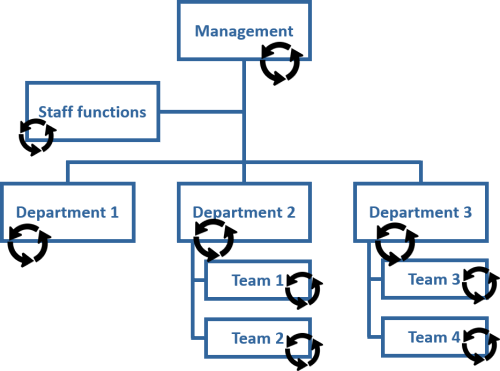

Does your business need to establish standardized structures for continuous improvement (CI)?
It is the employees in the business who see the many small and sometimes also the slightly greater opportunities for improvement. The sum of all these improvement opportunities can make a significant contribution to the improvement in results.
The Lean Leadership Initiative includes proposals for structures to involve everyone in Continuous Improvement (CI) work. Such CI structures are important components of a strategic business improvement system (BIS). A system that will ensure predictable and targeted work with both strategic and ongoing operational improvement needs.
This post gives you input into the future state for such structures. The purpose is to simplify your work spent planning and reveal any competence needed for a successful introduction.
Read more: What are Lean and Six Sigma – and why should it be seen in context?
A comprehensive CI structure consists of standardized proactive and reactive improvement processes that engage everyone in the organization. These improvement processes define what is to be done and how to do it.
The improvement processes are owned and run by the line organization’s managers. The figure below illustrates the organization in a typical medium-sized business. The circles drawn illustrate linked improvement processes at all levels.
In this case, there are improvement processes at the team level, at the departmental level and at the management or staff level. The fact that the processes are linked means that the improvement processes have inputs and outputs that are linked to contribute to the best possible management of the company’s improvement needs.
For example, an output from the team level process may be issues that must be escalated to the department level. There may be issues that the team has no authority to do and/or issues that the team observes, but that have root causes outside the team’s area of responsibility.

The formal descriptions of the improvement processes at the various levels should include:
To give you an understanding of how an improvement process can work, we describe in the next section the CI process as it can be in a department.
Look for a department that has chosen a quarterly cycle for its improvement process. Four weeks before the end of the quarter, the department head and the general manager meet to prioritize the next quarter’s improvement work.
The priorities are the existing improvement proposals, the key figures for the department and the department’s tactical action plan. The improvement proposals come from the company’s proposal system. The key figures indicate the status of the department’s performance and its processes. These key figures are often grouped into the following categories:
The department’s tactical action plan is a result of the company’s strategy process and describes, among other things, planned improvements needed to achieve long-term strategic goals.
Based on this, the improvement targets will be prioritized and decided next quarter. As a result of the decision, the Head of Department engages the right people in the process of analyzing the problems and identifying the improvement activities to be undertaken. The analysis must be completed by the end of the current quarter.

In order to support the participants in the analysis, tools are often used for value stream analysis, root cause analysis, risk analysis, prioritization and data analysis. The identified improvement activities are then included in the department’s operational action plan for implementation and follow-up in the next quarter.
It is considered important to carry out the planned improvement activities. The CEO should therefore regularly and formally monitor the progression of the operational action plan. Delays should in principle not be accepted. In the event of delays, the Head of Department shall take corrective measures to recover the lost.
The table below provides an overall description of the analysis phase of the department’s improvement process. The analysis phase is thus what happens from prioritizing problems or opportunities up to the decided updating of the operational action plan.
In order to measure the activity level and be able to compare departments, implemented improvements must be logged. Problems that require root cause analysis are documented on a template for this (often called A3 template) and published for reuse on the intranet.
Improvement opportunities and problems that cannot be resolved within the department are escalated to the next level above the department level or passed on through the proposal system of another department.

It is imperative to be realistic in terms of the ability to handle complexity when the business implements standardized structures for continuous improvement. It is therefore recommended to start with a few prioritized activities and then increase complexity as skills and ability increase. Targeted training is essential to help make this development happen.
The proactive improvement processes at the team level will have a higher frequency and lower complexity than at the departmental level. For some teams, a few hours of analysis and planning may be sufficient every two weeks. Planned improvement activities are described in a simple plan that also provides room for improvement needs that may arise during the period.
Many businesses also need reactive improvement processes in addition to the proactive (planned) ones. The reactive improvement processes are also formal and typically define who, what and how to proceed when events occur or problems that require “immediate” and methodological approach. HSE-related events normally require such an approach.
You have now acquired some insight into what formal structures for continuous improvement are all about. These structures are key components of the company’s comprehensive Business Improvement System (BIS).
Maybe you are curious about other content in BIS and how to implement BIS? If “Yes”, then we have created a guideline you can download by clicking the button below – it is of course completely free.


